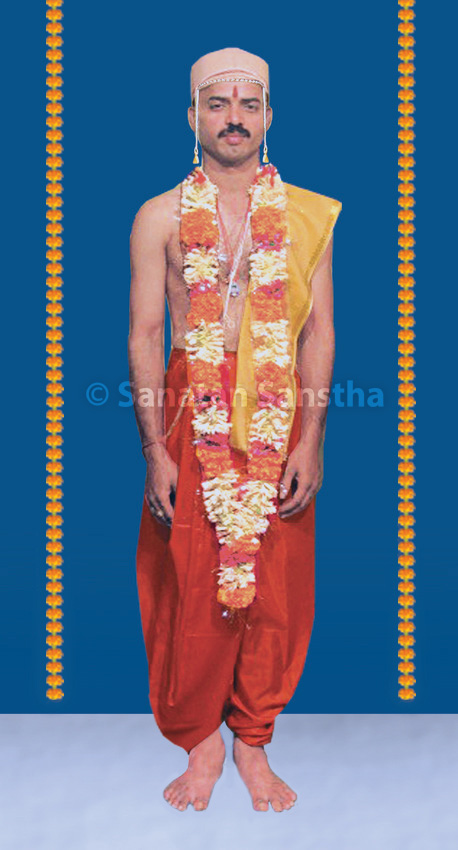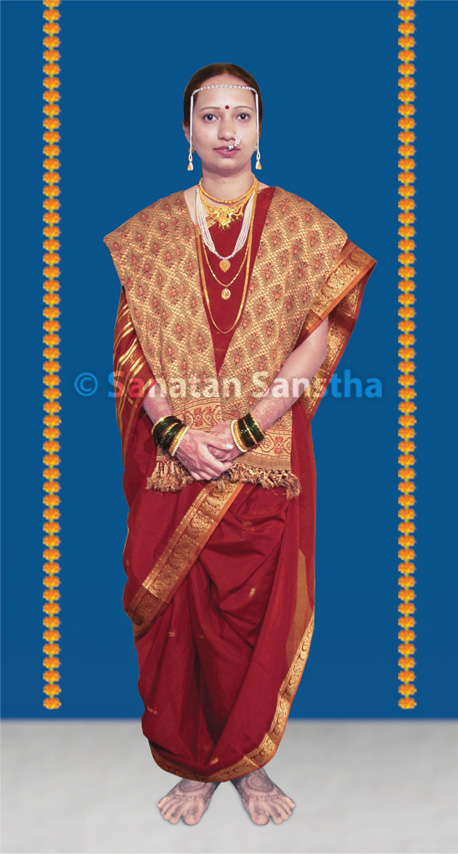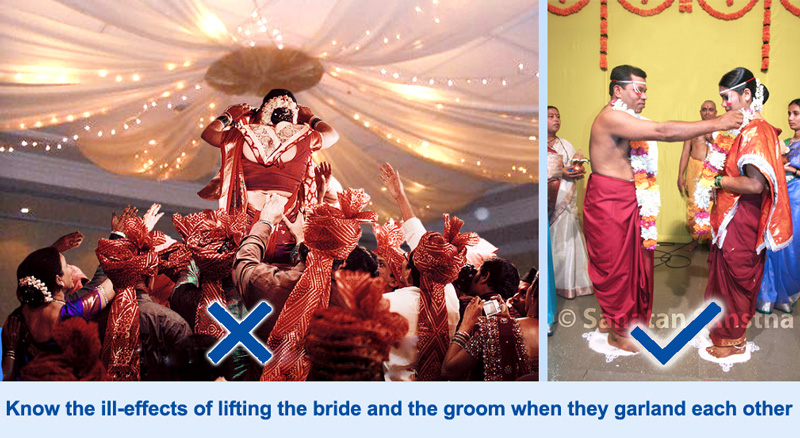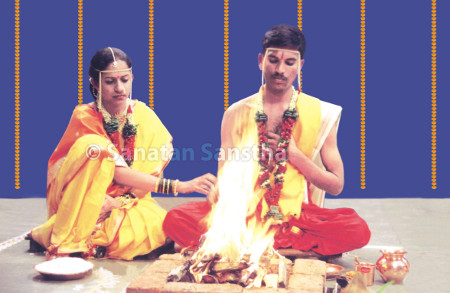Hindu Dharma has advised sanskars to be performed during the sixteen principal events of life, so as to move closer to God. The most important of them being the ‘Vivah-sanskar (Hindu marriage sanskar)’! The true objective of a vivah (Hindu marriage) is that two individuals seek the blessings of God to lead a compatible and happy married life! For this, it is absolutely essential to perform the ritual of Hindu marriage strictly as per the scriptures. This article answers various questions on vivah sanskar and the rituals involved.
1. What should be the age for vivah (Hindu marriage)?
In the earlier times, at the age of eight after the upanayan sanskar (Thread ceremony), a boy would remain in his Guru’s (Spiritual Master) hermitage for at least twelve years. Thereafter, before entering the stage of Gruhasthashram, for four to five years he would make efforts to develop the ability to earn a livelihood. Giving due consideration to all this, the age group of twenty-five to thirty years was considered as ideal for a boy’s marriage. Once the girl crossed her childhood stage, for the next five to six years she was taught how to shoulder worldly responsibilities. Hence, the age group of twenty to twenty-five years was considered ideal for marriage for a girl. From the spiritual perspective in the current period too, the above mentioned age groups are ideal for marriage of boys and girls.
2. Is it appropriate to print pictures of Deities on invitation cards?
It is a practice to print pictures of Deities on Hindu marriage invitation cards. Often the Name of the Deity is printed alongside. After the marriage, these invitation or greeting cards are thrown into the dustbin or elsewhere, resulting in denigration of the Deity. Based on the spiritual principle that ‘word, touch, form, taste, odour and their Shakti (Divine Energy) co-exist’, wherever there is a form or Name of a Deity, the Principle of that Deity does exist. Therefore, the thought that pictures of Deities should not be printed on marriage invitation cards or greeting cards is very natural. However, the benefit derived from the Principle of the Deity from its picture is more than the spiritual harm taking place due to its denigration. This will be clear from the explanation given below.
| Pictures of Deities | Proportion of Creation, Sustenance and Dissolution (%) |
|---|---|
| Creation | 20 |
| Sustenance | 50 |
| Dissolution | 30 |
| Total | 100 |
Making marriage invitation or greeting cards with pictures of Deities and using them amounts to Creation and Sustenance. Their respective proportion of 20% and 50% totals 70% (which means that the benefit from the Deity Principle is so much). In comparison, discarding marriage invitation or greeting cards with pictures of Deities or their becoming unusable (getting spoilt) is 30%. This means that the exact benefit derived from pictures of Deities is (70-30=) 40%. Additionally, Creation and Sustenance last longer than Dissolution, meaning Dissolution takes place faster (the duration of loss is small); for example, when denigration of Deities takes place, the Deities there cease to exist. Considering these facts, it can be concluded that printing pictures of Deities on marriage invitation or greeting cards is appropriate. However, when these cards are no longer in use, it is appropriate to immerse the pictures of Deities on them in flowing water.
3. What should a groom wear ?

Religious rituals like vivah include rituals such as hom-havan (Sacrificial fire), recitation of Sanskrut mantras, blessings from elders etc. As a result, sattvik (Sattva-predominant) waves are attracted to the venue of a marriage. For imbibing these sattvik waves, bride and groom should wear sattvik clothes.
-
A groom should not wear clothes such as shirt-pant, coat-tie which are stitched from synthetic fibres; because tamasik (Tama-predominant) waves are imbibed by them. He should wear clothing such as sovale-uparne or a kurta-pyjama made from natural fibres like cotton or silk. These clothes imbibe sattvik waves in greater proportion.
-
The groom’s clothes should not be of very bright (tamasik) colours. They should be of sattvik colours such as white, cream, blue, pink etc.
4. What type of sari should a bride wear?

During the rituals of vivah (Hindu Marriage), Chaitanya (Divine consciousness) gets attracted to the venue of the marriage. If a bride wears a six-yard sari, she imbibes 30% Chaitanya and if she wears a nine-yard sari, she imbibes 60% Chaitanya. Hence, a bride should wear a nine-yard, cotton or silk sari which have sattvik colours such as red, orange, blue, yellow, pink.
5. In religious rituals like vivah, why is an uparne or shawl draped around the shoulder?
During vivah rituals, worship of Deities, Abhishek etc. the proportion of Shakti waves being received from God is greater. These waves can cause distress such as heaviness of head, burning in the eyes etc. When men drape an uparne around their shoulder and women take a shawl, such waves do not cause any distress; on the contrary, they are able to absorb only the required amount of these waves from the venue of the Hindu marriage. Besides, a protective sheath is created around them, thus protecting them from the attacks of negative energies.
6. What are the ill-effects of lifting the bride and the groom when they garland each other?

In some places, while exchanging garlands during the vivah ceremony, to tease the groom and make it difficult for him to garland the bride, the bride is lifted. At times, the groom too is lifted. This inappropriate action obstructs the vibrations of Deities attracted to the venue of the Hindu marriage. In fact, this action leads to emission of Tama vibrations into the environment. Taking advantage of this, negative energies in the atmosphere emit vibrations of black energy at the venue of the Hindu marriage. This can affect the groom and the bride.
7. During the ritual of vivah and also when performing a puja (Ritualistic worship), why should the wife sit to the right of her husband?

A wife is considered to be the better half of the husband. In the role of Shakti (Divine Energy) of Shiv, a wife has to support her husband in every karma. During ritualistic worship, the wife providesShakti to her husband by touching his right hand with her four fingers. A karma performed by the host husband-wife becomes fruitful with the support of Shiv and Shakti. Only during a Yadnya-karma the wife should sit to the left of her husband.
8. Why should a husband and wife pay obeisance together after their vivah (Hindu marriage)?
Vivah means blending of Principles of Shiv in the form of husband and Shakti in the form of wife. Every act is taken to its completion jointly by performing that act through the sagun (Materialised) Kriya-shakti (Energy of action) in the form of Shiv and giving further momentum to that act through the nirgun (Non-materialised) Shakti. After Hindu marriage, both the individuals enter the householder stage. It is very important to obtain the blessings of elders jointly to perform various activities in life in the householder stage by complementing each other. Paying obeisance together leads to activation of the waves of Shiv and Shakti in the Universe. This helps in developing humility in the individuals. It also results in fulfilment of every deed in the householder stage and yields desired fruit from it, leading to possibility of minimum give and take. That is why, after Hindu marriage, a couple is required to perform every act together and should comply with each other even in an act like paying obeisance. This is the only aim underlying the act stated above. If amongst the husband and wife only one is available, then he/she can pay obeisance individually.
9. While paying obeisance together, on which side of the husband should the wife stand?
Wife is the Shakti of Shiv; she is also the right nadi (Energy channel) of the husband, meaning the one that provides energy to the mission. Hence, while paying obeisance together, the wife should stand to the right side.
Reference : Sanatan Sanstha’s Holy text ‘Marriage sanskar’

